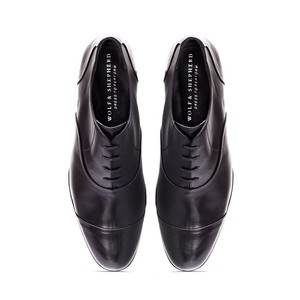Shoe shines
Published: May 4, 2015 / Author: Nicole Velasquez

Men’s footwear sleek enough for Wall Street? Comfortable enough for city walking? High-performance enough for skateboarding? Yes, says McCloskey Business Plan Competition winner.
Just a minute, Justin Schneider. Can men really surf, skateboard and jump hurdles in Wolf & Shepherd dress shoes, like you do in your website videos?
“Yes,” says Schneider, the company founder, 2011 Notre Dame industrial design alum and former shoe designer for Adidas, New Balance and Reebok. “Well, I’m not speaking for what a guy wearing the shoes is or isn’t able to do. But the shoes can handle anything.”
Aimed at young professionals, Wolf & Shepherd shoes are stylish with calfskin leather uppers. They’re durable with replaceable heel and footbed. Above all, they feel like a high-performance athletics shoe, incorporating high-tech material such as EVA heel cushioning and memory foam insoles. In designing the footwear line, Schneider’s goal was to incorporate innovation and technology to a largely unchanged field. “Traditional men’s dress shoes are made with wood and nails,” he says. “Why are we walking on wood and nails in the 21st century?”
WINNING WITH STYLE
Wolf & Shepherd’s answer to this question earned the company the top spot over 145 other teams in the 2015 McCloskey Business Plan Competition, which held its final event on April 17 at the University of Notre Dame’s Mendoza College of Business. The shoe company stylishly walked away with the $25,000 cash prize from the event, which awards $300,000 annually in cash and in-kind prizes.
Among this year’s ventures were a handheld blood testing system, a mobile app for inexperienced investors to pool resources together, an organic vodka that uses water from Vermont maple tree sap and a water purification system for recreation or use in developing countries that need access to clean water.The competition consists of four rounds over nine months with judging by 221 business professionals. Open to all Notre Dame students, alumni and faculty, each team must include at least one current Notre Dame student.
“The competition this year was an even better experience for our students,” says Karen Slaggert, associate director for the Gigot Center for Entrepreneurship at the Mendoza College of Business, which sponsors the competition. “The number of current students involved increased significantly, and they did an outstanding job representing these ventures in the final rounds. The judges were so impressed by the quality of ventures and by the presentations.”
AN UNBELIEVABLE EXPERIENCE
A new rule required each team to include a current undergraduate or graduate student. That student alone was responsible for presenting to judges in the semifinal round on April 16, which narrowed the field from 20 teams to six.
Before she made the pitch that propelled Wolf & Shepherd to the final round, Gutierrez also spent months with Schneider and other team members working on the business plan. She specifically focused on market segmentation and launch strategy. “I really was able to apply everything that I learned in my academic classes into a business context,” she says. “This has been my best experience at Notre Dame. It was unbelievable to be able to pitch to judges and get feedback from alumni who are so invested in helping students.”Cristina Gutierrez, a junior majoring in finance and psychology, gave the 5-minute pitch for Wolf & Shepherd, who admits she was a little nervous to shoulder such a responsibility. “I found online guides on how to draft a pitch, and then I watched pitches for hours straight,” she says. “It was an incredible opportunity to deliver our presentation.”
LEAN ON THE NETWORK
Not only is the McCloskey competition valuable for the winning ventures, it can have a tremendous impact on ventures that don’t win. Take ND alum Evan Wray and his company Swyft Media, for example. Wray spoke to the competing teams just before 14 of them were eliminated on April 16. He recalled how he and his friend Sean O’Brien entered the McCloskey competition as seniors in 2012 — and how they were eliminated early. “I wasn’t even here [in the semi-final round],” Wray said. “I wasn’t in the room.”
“A lot of our company’s success was seeded here at the McCloskey competition,” Wray said. “Through McCloskey, we met a lot of people who advised us along the way. We leaned pretty heavily on them for everything that we were doing. I am so very, very grateful for that. One of the coolest things about Notre Dame is that even though I wasn’t in the business school, and I didn’t even make the finals of the McCloskey competition, people were still more than happy to help out. I want to encourage everyone in this room to lean on the network, lean on the people here. Don’t be afraid to ask for advice because it’s really important.”But the two didn’t give up on their idea of creating emojis, tiny electronic illustrations such as smiley faces, animals or a thumbs-up, for different corporate brands, such as the Notre Dame leprechaun or Mickey Mouse. With the help of connections they’d made through the McCloskey competition, they refined and expanded their original idea. Despite almost running out of money and other ups and downs, Swyft Media was acquired this year for $27 million by Monotype Image Holdings, a 125-year old type company.
Related Stories




